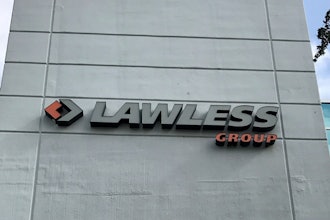“Your company’s goal is to make money or it’s not in business.” Eli Goldratt
The call was from the CEO of a distribution company doing $30 million a year in sales. He had a question.
"Last year we wrote off $5,000 to bad debt: do you think we're too tight on credit approval?" A $5,000 loss on $30 million in sales works out to .000166%, which is a tiny number. I needed more information.
I asked him a couple of questions: First, do you have any unused capacity? Could you take on more business without having to hire any new people or take on any additional fixed costs? The answer was "yes", they could take on more business without any more fixed expenses because of the underutilization of their capacity to do business.
The second question I asked was if he was currently turning down credit sales and rejecting riskier credit customers. Again, the answer was "yes". His CFO had established a credit profile based on the type of business a new customer was engaged in, how long they had been in business, and on the way they had handled credit in the past (based on a credit report). If a new customer waiting to buy didn’t measure up, the sale was rejected ... end of story.
I then asked the CEO to draw a bar graph representing his current sales and, to keep things simple, to make the amount $100. The first 5%, or $5, was to be the pretax profit. The next 45%, or $45, was variable expenses including cost of goods, sales commission, and the cost of carrying A/R (time value of money) and any bad debt. The remaining 50%, or $50, was the fixed expenses. He said I was off a few percent here and there, but he got the idea.
I then asked him to draw another bar graph representing a 10% increase in sales via riskier credit sales. Of the new riskier sales, a whopping 10% would fail to pay and would be written off as a bad debt loss. The 10% in bad debt would be thousands of times higher than his current loss. $1 of the new riskier sales would be lost. Variable costs would remain constant at 45%, or $4.50 of the new sales.
Due to unused capacity, there would be no additional fixed expenses and the pretax profit on the riskier credit sales would leap from 5% to 45%, a 900% improvement because of the effect of the product value at time of sale in the form of unused capacity.
$100 Current Sales | $10 Riskier Sales |
50% or $50 | 10% or $1.00 |
45% or $45 | 45% or $4.50 |
5% or $5 | 45% or $4.50 |
Fail to take into consideration the product value at time of sale in the form of unused capacity and you may well be passing up some of your most profitable sales. The distribution company CEO? I ran into him at his association's annual meeting and his sales and A/R were up to record levels, as was his turn time on the A/R and bad debt losses (but nowhere close to 10%). His greatest obstacle in factoring in the product value at time of sale was his CFO, who had always been told "that all bad debt is bad.” He said to me “I’ve never made more money in my life.”
Other Examples of Product Value at Time of Sale
A distributor of ski hat pins and sunglasses was writing off 20% of all credit sales. The only requirement for credit terms was that the customer provide a name and street address for shipping; that was it. They did, however, have a minimum sale policy.
Most companies couldn't survive for long with such high bad debt write offs, but this company was only paying 3 cents for a hat pin and selling them for $1, a markup of 3333%. The "product value at time of sale was very low. They could have written off 50% of sales to bad debt and been down to a 1666% mark up. Of course, the opposite is true of products with a high cost and low markup, they have a high product value at time of sale.
Industrial distributors have a much higher cost of goods sold than expressed in this example. They generally have a 75% cost of goods sold with 25% gross profit.
A trucking company had a truck going from Denver to Omaha. On the return it was empty. What was the PVaToS (product value at time of sale)? Keep in mind that it's uphill from Omaha to Denver. Zero? Less than zero!
The PVaToS was a minus. Minus the driver's pay, gas, insurance, and maintenance. Knowing there was a negative product value involved, a customer who'd paid slow in the past was contacted. By getting 25% down and by extending 60 day terms on the balance, a load was found. And if this flaky customer failed to pay the balance they were still money ahead because of the product value at the time of the sale.
Slow turning Inventory has a low "product value" as do products with a short shelf life. An airplane seat empty when the door of the craft is closed has a low "product value"; that's why two people sitting next to each other can pay very different fares. Services businesses with high demand have high "product value". The same companies with low demand have low "product value".
When approving credit, most companies do a pretty good job of weighing a customer's profile, time in business, etc. They do a fair job of checking past credit history. Where they fail is in taking into consideration their product value at the time of the sale.
| Base Business | % to Sales | Incremental Business | % to Sales | Total Business | % to Sales |
Sales | $30,000,000 | 100.00 % | $3,000,000 | 100.00% | $33,000,000 |
|
Fixed Expense @ 50% | $15,000,000 | 50.00% | $0 | 0.00% | $15,000.00 | 45.45% |
Variable Expense @ 45% | $13,500,000 | 45.00% | $1,350,000 | 45.00% | $14,850,000 | 45.00% |
Incremental Risk Bad Debt @ 10% | $0 | 0.00% | $300,000 | 10.00% | $300,000 | 0.91% |
Net Pre-tax Profit | $1,500,000 | 5.00% | $1,350,000 | 45.00% | $2,850,000 | 8.64% |
Assumptions: 1) The normal credit risk is part of the fixed costs of the company. If credit risks are increased to stimulate additional business, they are reflected on the Incremental Risk Bad Debt line. 2) This equation will work if you can leverage additional business over your fixed costs (i.e. plant, equipment, rent, etc.) Once full capacity is met and additional investment must be made in the company infrastructure, the equation must be recalculated. 3) This company described above was able to increase sales by 10% utilizing the existing capacity of the company. They increased their sales by extending credit to customers who represented marginal credit risks over their existing customers. Although their credit loss increased, their profits increased substantially! Graph courtesy of: Ron Fleisher, Creative Bottomline Solutions, Inc.
It may seem like a contradiction, but there are times when more bad debt can mean an improvement to the bottom line.
Product Value at Time of Sale in the form of demand, margin and capacity to do business should be considered in all new and repeat or additional sales to existing customer, and the PVaToS should be known on every invoice . . . lest you start thinking that slow pay customers are bad or that all debt is equal or bad.
Abe WalkingBear Sanchez is the developer of the copyrighted Profit System of B2B Credit Sales Management. An international speaker and trainer, he is the endorsed consultant for PEI and STAFDA. You can learn about his business – A/R Management Group – by visiting www.armg-usa.com. You can reach him at [email protected], or by phone at 719-276-0595.






















